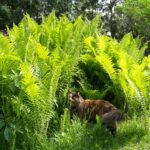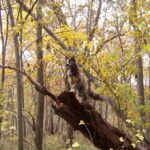One morning while watching the arrival of spring migrant birds, we were startled and annoyed to see a cat lurking under the feeder seeking a bird victim. We so enjoy the Summer and Scarlet Tanagers, and Indigo Buntings at our feeders. They add diversity to our usual visitors – titmice, chickadees, cardinals, and woodpeckers who visit throughout the year.
We chased the cat away but began researching the history of domestic cats and their impact on wildlife. It’s both fascinating and concerning.
Challenges Facing Birds
Modern birds face many challenges, including habitat destruction, climate change, light pollution that disrupts navigation, and crashing into towers. However, the International Union for Conservation of Nature lists domestic cats as one of the world’s worst nonnative invasive species. They are the number one human-caused threat to birds in the United States and Canada and kill upwards of 2.4 billion a year.
Domestication of Cats

Cats have a strong hunting instinct.
People and cats have a long relationship. They were domesticated from the European wildcat over 10,000 years ago, probably in the Fertile Crescent. Wherever people have migrated to they’ve brought along cats. Even after so many years living with people this animal, Felis sylvestris, retains its predatory instincts, reproduces rapidly, and readily goes wild, or feral.
Domestic cats are fascinating animals loved by millions of people, so any criticism of them often brings a sharp emotional response. However, there’s no doubt they harm wildlife, and one of the main reasons is their artificial high population density.
Animal Territories
Wild predators, like cougars, bobcats, and wolves have vast territories. It takes plenty of land to sustainably produce enough prey for a predator to live. So, if they are crowded together they’d starve. A naturally occurring population of predators in a healthy ecosystem simply has few individuals. For example, a healthy population of native bobcats may have only a few individuals spread over several square miles. The same goes for wild native European wildcats in natural areas in Asia and Europe. The problem comes when humans crowd many cats into a small area.
- Feral cats can’t live in high density in a wild place but in a suburb many families living close together

Cats decimate bird populations.
allow their cats to roam outdoors. These cats get all or most of their food from people so they can live in unnaturally high densities. Even well-fed lap cats kill birds and wild rodents by instinct, even though they are not hungry. Too many cats per square mile are disastrous to birds.
How to Protect Birds at Feeders
Families that don’t want cats stalking birds can take a few actions to reduce the death toll of birds. These include:
- Asking neighbors to keep their animals in their home or yard.
- Placing feeders on metal “shepherd’s hooks” that cats can’t climb.
- Configuring a ring of wire mesh around feeding stations to exclude cats from catching juncos, chipping sparrows, and other ground-feeding birds.
Birds face many hazards in this modern world. Cat predation is one that can be reduced. Both cats and birds can enjoy a safer life if the owners of descendants of the European wildcat kept their pets indoors.


Many cat owners insist that it’s cruel to keep their cat indoors because they “have to” hunt. Not true. I have had 3 cats over my adult life and they were all kept indoors and never tried to escape. One of them was quite happy to be staked in the yard on a long leash where she could relax in the grass, and watch the leaves blow and the birds dart about, well out of her reach.
Thanks Sheri. Cats are fine as are most pets. Owners need to realize the toll that predators take on native wildlife. And, help wildlife that is in stress due to other changes in their environment keep viable numbers.